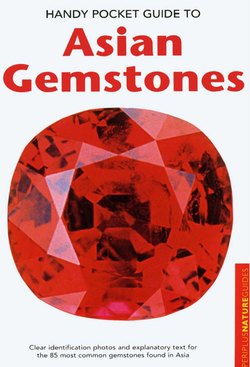Читать книгу Handy Pocket Guide to Asian Gemstones - Carol Higgins Clark - Страница 7
ОглавлениеRuby
Asian origins: Myanmar, Sri Lanka, Thailand, Cambodia, Vietnam, India
One of the most durable of gems—second in hardness only to diamond—the ruby is a crystalline form of aluminium oxide, infused with trace elements of chromium which gives the gemstone its red color. The name comes from the Latin word ruber, for red. Fine rubies are rarer than top-quality diamonds. They are also far more expensive, perhaps because red has always symbolized man's strongest passions, and no embodiment of red equals that of a first-rate ruby.
Today Myanmar is the most famous source of rubies. Nature embues the finest Myanmaran rubies with a red florescent glow, so that the stone scintillates with fiery life, like a translucent red-hot coal. Gem dealers call the color exhibited by Myanmaran stones "pigeon's-blood red," and large rubies bearing this description sell for millions of dollars. While Myanmar is the most well-known of Asia's ruby-producing countries, Sri Lanka, Cambodia and Thailand also have long traditions of ruby mining. Thailand's central location in the gem-rich region, combined with its relatively democratic government, have helped Thailand become the hub of the world's ruby trade. Most of the rubies from its neighbors pour into the country for processing and trading on the international market.
In 1992, rubies were discovered in northern Vietnam. The main deposits are in Nghe An Province, the poorest, most infertile region of the country, famous for producing tough soldiers and fiery revolutionaries—most notably Ho Chi Minh. Little did the long-suffering residents of the province suspect that their infertile soil held untold riches. When the valuable gems surfaced, they sparked a "ruby rush" in the province, even more fervored than the gold rushes of western U.S. lore. Thai gem dealers poured into Vietnam to pay cash for the rubies. Vietnamese subsistence farmers, used to earning less than US$100 a year, suddenly possessed valuable red stones which they could sell for thousands of dollars each.
A supervisor and digger at a ruby mine in Mogok, Myanmar
Photo by Carol Clark
Rough and cut rubies
Ruby from Myanmar, cushion cut
Ruby from Sri Lanka
International Colored Gemstone Association (ICA) photos
The Nga Mauk Ruby
The ruby is one of Asia's most revered gemstones. In India, it is known by the ancient Sanskrit names ratnaraj, "King of Gems," and ratnanayaka, "Leader of Gems." The Hindus believed that he who made offerings of rubies to the god Krishna would be reborn as a powerful king. The Myanmaran word for ruby—ma naw ma ya—means "desire-fulfilling stone." According to Myanmaran tradition, wearing rubies will make your wishes come true. The gems are also believed to give their wearers sexual appeal and protect them from danger.
One of the oldest sources of rubies is Mogok, in Myanmar. A legend attributes the founding of the town in AD 579 to a tribe of headhunters from nearby Molmeik. Throughout history the Mogok mines have produced rubies sought after by sultans, emperors and maharajahs. The Myanmaran kings, however, laid first claim to all significant stones of Mogok.
Failure by a miner to turn over a large ruby to the king brought dire consequences, as illustrated by the tale of Nga Mauk. This miner found a magnificent stone in 1661 which broke in half along a flaw—either by accident or design. Nga Mauk dutifully presented one 81-carat piece to the king but he could not resist the temptation of selling the other half privately. Shortly afterwards the king held a party at his palace in Mandalay. When he brought out the ruby to proudly show his guests, an Indian merchant said he possessed a stone of equal beauty and showed the king. Enraged, the king ordered Nga Mauk burned alive at a site now known as Laung Zin, or "fiery platform."
The Nga Mauk Ruby disappeared in 1885, when the British overthrew King Thibaw, the last king of Myanmar, and seized the palace in Mandalay. Some Myanmarans believe that the British took the stone and recut it for their crown jewels. Others, however, point out that the ruby could have just as easily been stolen by servants.
Rubies from Thailand
Rubies from Orissa, India
ICA photos
Sapphire
Asian origins: India, Myanmar, Sri Lanka, Thailand, Cambodia, Vietnam
The sapphire is the serene, more subtly beautiful sister stone of the ruby. Both gems belong to the corundum mineral family and are essentially crystallized aluminum oxide. Red corundum—which consists of aluminum oxide and traces of chromium—is called ruby, while blue corundum—colored by traces of titanium and iron—is known as sapphire. Like rubies, sapphires are second in hardness only to diamonds.
Corundum containing other trace elements appears in a spectrum of colors, including yellow, violet, pink, green and orange. Any corundum gemstones which are not red or blue are called "fancy sapphire."
Blue is by far the most popular of the sapphire colors. The name derives from the Greek sapphirus, for blue. Since early times, the sapphire has been associated with celestial forces. In ancient Sanskrit it is referred to as sauriratna, "sacred to Saturn." Buddhists consider the sapphire a symbol for peace and faithfulness in love, making it a popular choice for an engagement ring gem.
